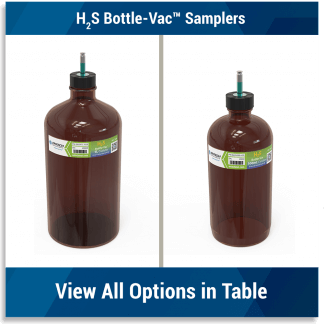Federal law requires a number of states to reduce smog-producing emission of volatile organic compounds (VOCs) from pesticides in areas that do not meet air quality standards.
H2S Bottle-VacTM Samplers
Overview
H2S and Methyl Mercaptan recovery has continued to be a analytical challenge when sampled into canisters at PPB to sub-PPB levels. The presence of more than 10–15% relative humidity within a sampling canister has been shown to dramatically reduce reliable storage time of H2S and to a lesser extent Methyl Mercaptan, relative to dry samples.
Fortunately, Entech offers an economical solution. Now, laboratories can choose to collect H2S and Methyl Mercaptan samples into new H2S Bottle-VacTM canisters. These canisters are designed to accommodate a specific amount of Silica gel within the sampler in order to dehydrate the sample upon collection. This small amount of Silica gel effectively removes more than 90% of the water vapor without effecting quantitative recoveries of H2S and Methyl Mercaptan. Easily collect H2S, COS, and MeSH into 500mL and 1L H2S Bottle-VacTM canisters and reliably retain >80% recovery even after a 1–2 week storage time prior to analysis. For the collection of heavier sulfur compounds which are less affected by humidity levels, simply utilize standard Bottle-VacTM or Silonite® canisters.
Low Pressure Reduced Sulfur (0.1–100 PPB)
Sulfur gases can be collected and analyzed using Silonite® coated samplers and canisters. Sulfur compounds have been shown to be stable in Silonite® canisters for 1–2 weeks, allowing sufficient time to perform laboratory analysis, even if samples must be shipped over long distances after sampling. Odor threshold levels can be met using GCMS or GC/CLD (Chemiluminescence Detector) when preconcentrating 10–200cc of sample.
Maximum stability of H2S and Methyl Mercaptan requires relative humidities to be below 20%. When the relative humidity is above 20%, excess water can be absorbed using Bottle-Vac samplers that contain a small amount of anhydrous Silica gel. Just enough Silica gel is used to absorb most of the water without affecting H2S or Methyl Mercaptan concentrations, allowing these compounds to be stable for weeks. When monitoring a wider range of sulfur compounds, it is recommended to use two different samplers; the 29-BV500-H2S or 29-BVL1-H2S for H2S and Methyl Mercaptan, and a standard Bottle-VacTM or Silonite® coated MiniCanTM or larger Silonite® canister for all other compounds. Silonite® coated cylinders are also available for high-pressure refinery gas sampling environments and long-term storage requirements.


